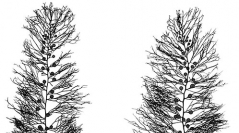

 Cryptogamie, Algologie
28 (4) - Pages 325-335
Cryptogamie, Algologie
28 (4) - Pages 325-335Sargassum desfontainesii (Fucales, Phaeophyceae), an Atlantic species recognisable by the unusual shape of blades (filiform and several times forked, instead of the typical leaflike laterals of most species of Sargassum) is morphologically re-examined in populations from the Canary Islands. Previous descriptions were exclusively based on pressed dried specimens and they are inexact for several diagnostic features. Fresh specimens exhibit (1) primary and secondary branches regularly cylindrical with smooth surface (never subangular, slightly compressed or spinous), (2) blades exclusively terete (never linear or triquetrous with a central percurrent midrib), (3) vesicles mostly muticous, but vesicles ending in a short coronal blade, or supported on a forked stalk are relatively common, and (4) male receptacles longer and more slender than the androgynous receptacles. Although until now the species has been considered as a genuine member of the subgenus Phyllotrichia, Sargassum desfontainesii lacks certain distinctive features, such as the distichous and compressed primary branches, and the linear, pinnately branched lower blades. It is suggested that this species should be placed in the subgenus Sargassum, section Malacocarpicae, subsection Cymosae.